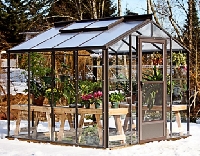
Raising plants in a greenhouse is easy when you follow some basic rules.
The primary advantage to raising plants in a greenhouse is the ability to grow things outside of their normal region, or outside of their normal growing season. Gardeners can get a jump on seed starting in the early spring and, if done well, even grow plants year round. That being said, greenhouse gardening isn’t foolproof. Many a gardener has lost their entire crop to disease, pests, or unregulated temperatures by failing to take a few simple but crucial measures when utilizing this most handy of gardening methods. Here are a few simple tips to keep in mind for successful greenhouse growing all year long.
Location, Location, Location
You’ve done the research and selected the perfect greenhouse for your purposes. Now, where to put it? You may have thought it would fit perfectly next to that stand of juniper trees in your back yard, but will it get enough sun, especially in winter months? Be sure to locate the structure where it will have access to full sun for at least 6 hours on any given day. You can always cover it with shade cloth in the heat of the summer, but you don’t want to have to invest in whole systems of artificial grow lights if your greenhouse isn’t getting enough of the real stuff due to a less than ideal location.
~
Let Them Breathe
Ventilation is the next most important consideration when growing in an enclosed space. A stuffy, stagnant room, chock full of moist dirt and plant life, is the perfect invitation for mold and disease. Be sure the greenhouse you select has adequate ventilation built in so you can open it up (or turn on a fan or both) on a regular basis, while watching the thermometer closely to be sure it’s not getting too cool in there on brisk days. Beyond ventilation, however, it is also good practice to space your plants apart enough that air can circulate between them. Not only will this keep mold and disease from spreading one plant to the next, it will also slow down a potential infestation if you accidentally introduce a pest-ridden newcomer to your pampered crops.
Feed Me, Seymour
Whether potting plants in basic soil or setting up a full hydroponic system, plants need to eat. Do not skimp in this area. Be sure to start with a well fertilized growing medium ? compost and loam for most gardeners ? and amend your basic mix to the needs of the specific plants you are raising. And then, like any good container gardener, fertilize plants when needed. The same goes for watering. Don’t forget to test surface soil daily and water when it feels dry to the touch. Follow feeding and watering instructions for specific plants accordingly.
Temperature
The basic purpose of a greenhouse is to create a controlled climate, so make sure you’ve got an accurate, easy to read thermometer operating at all times. And do not underestimate the power of the sun, especially in the winter, to come out from behind the clouds and heat things up quickly. Adjust ventilation and shade as needed, and monitor frequently. It is very easy to assume your little green lovelies are slumbering peacefully in sub-zero temperatures (it’s why you have a greenhouse, after all), when in reality the high January sun is cooking them where they sit.
Pests
What, you thought greenhouses didn’t have to worry about bugs and slugs? Think again. But, as in any garden, your number one defense against a devastating pest infestation is to keep your plants strong and healthy. One hot, under-watered tomato can attract a whole fleet of spider mites, which can then attack other healthy plants once they’ve finished off the easy prey. If you find a culprit riddled with pests, remove it from the greenhouse at once, and then either rinse off the bugs and baby the plant back to good health if you really want to save it, or destroy it if it looks beyond hope. You do not want to risk losing everything you’ve got for one weak specimen. Keep the area clean and ventilated, and watch plants closely. Thoroughly inspect any new additions to the house before bringing them in. Take care of issues quickly, and you should be able to manage any insect intruders before they become problems.

